When you receive an invite for a press trip to go and ride somewhere as famous as Tuscany, you instantly build up mental images of what it will be like. But the organisers of the soon-to-be-launched Terre Di Pisa Bike Trail didn’t want us to see the Tuscany that everyone else visits. Their plan was for us to get really off the beaten track. Ancient villages, breweries powered by volcanic steam, varied riding, awe-inspiring views and river crossings were all on our agenda.
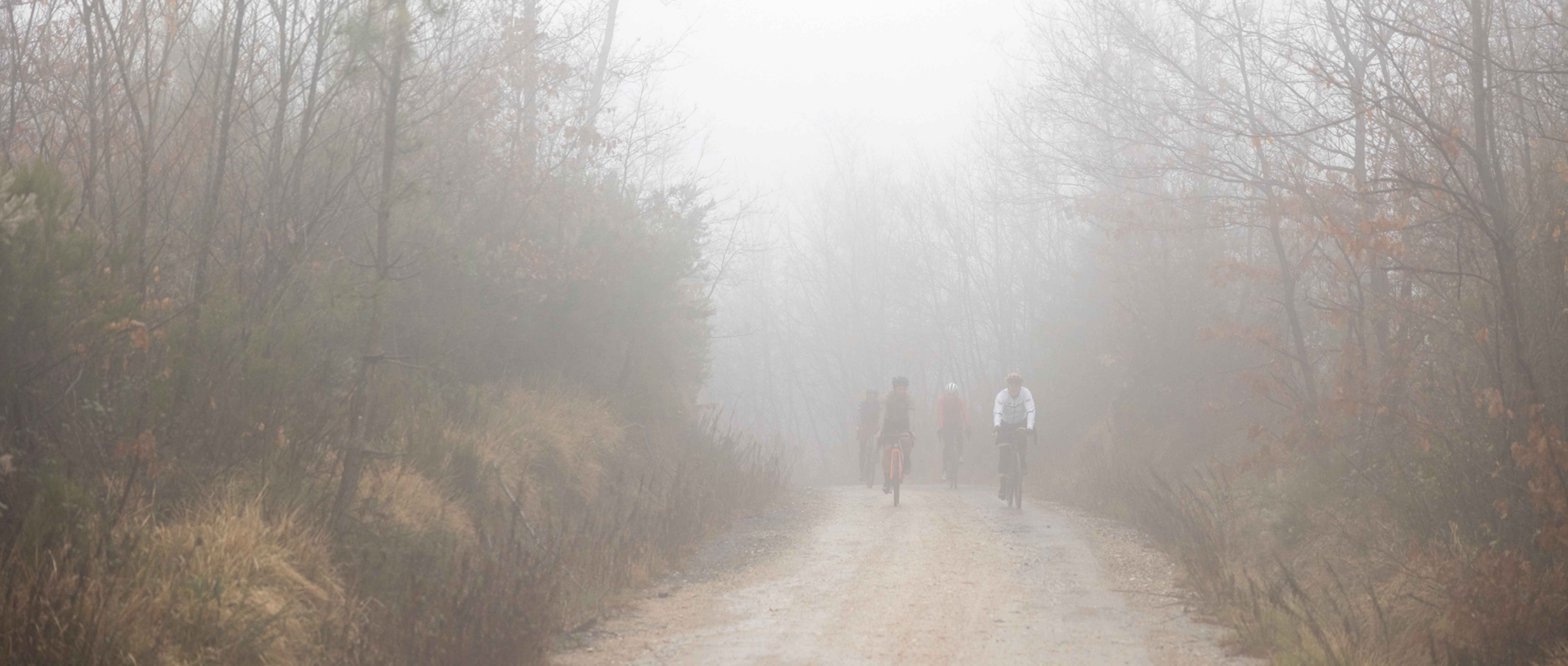
Image courtesy of Erwin Sikkens
Wooomph……Woooomph…..Wooooomph. The noise was familiar, yet otherworldly. It was impossible to see the source, but you could sense it. The feeling was quite discombobulating. What the hell was the sound and where was it coming from? It was only as our group inched our way ever higher that we reached a clearing and realised the noise was coming from the vast, metallic blades of a wind turbine. Each rotation caused the blades to scythe through the damp air. Our proximity meant we could feel the movement as much as see it. The saturating fog was all-encompassing, wrapping us in its cloying embrace. Sound was muffled and vision was restricted to a matter of meters. Fortunately, the trail under our tyres was smooth and vehicle width – nothing too difficult to tackle, even when riding by feel more than vision. This was not what the weather forecast had predicted. It certainly wasn’t what the marketing team at the Terre Di Pisa Bike Trail would have wanted. “Welcome to our beautiful, sun-dappled region” would probably have been higher up their list of desires for creating the perfect first impression.
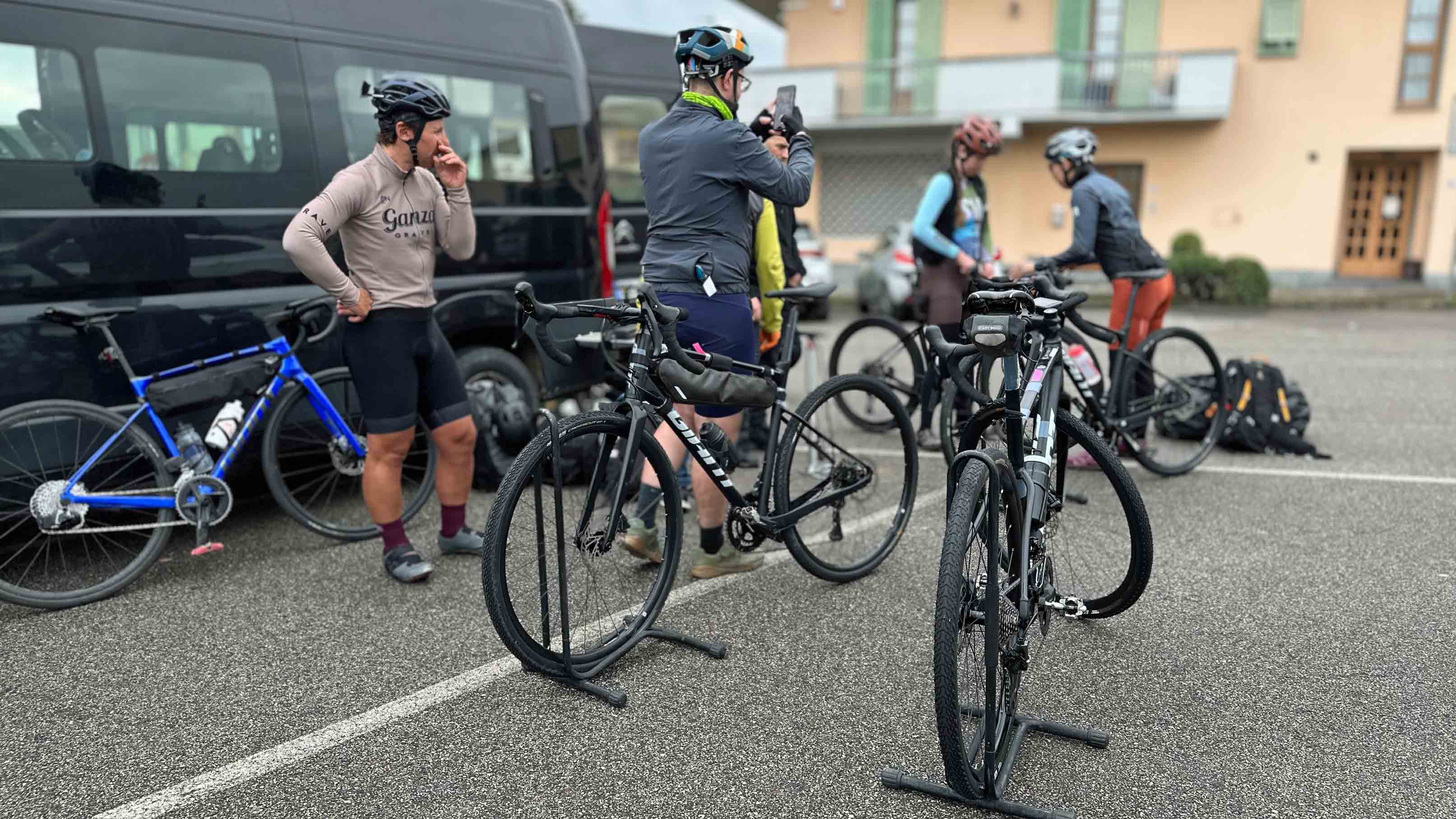
As we clambered out of the transfer vehicle at the start of our first day of riding, stomachs still full of the delicious six-course tasting menu that we had sampled late the evening before, the air was full of pent-up energy, enthusiasm and perhaps even a little first-day-at-school type nerves. Press trips always have an interesting dynamic in that a seemingly disparate group of individuals, frequently from opposite corners of the globe and always with completely different expectations of what they want (and need) to get out of the trip, are squashed together with only one thing in common – a shared love of cycling.
The Terre Di Pisa Bike Trail is mainly aimed at experienced gravel riders and bikepackers and with more than 10,000m of climbing shoehorned into the 530km total length, it’s designed as a good challenge for both rider and bike. The route was co-created by friends and local residents Daniele Pelorossi and Daniele Papini and both were supporting our press trip, the former as our riding guide and the latter as our support driver/mechanic/mobile snack stop/Mother Hen.
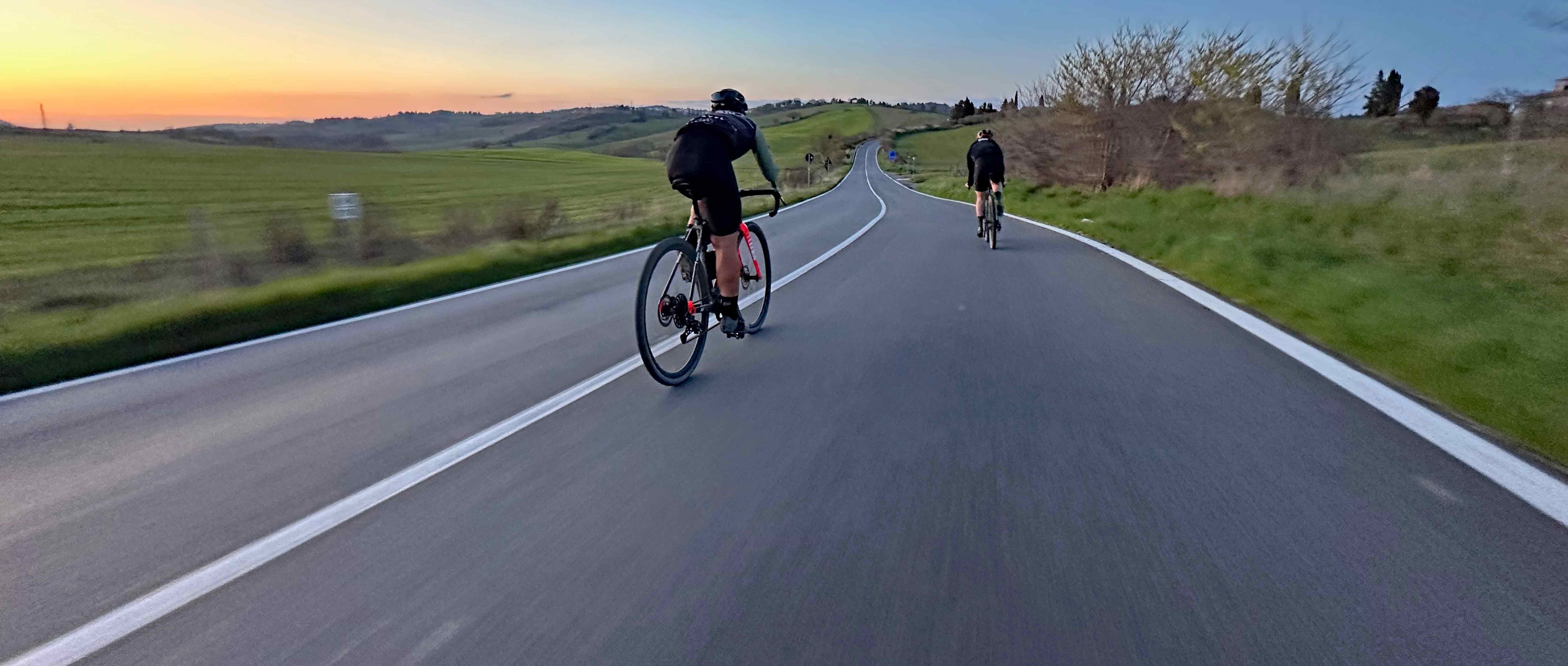
During our press trip, we sampled three diverse sections of the overall route. When the advance details of the riding were sent through, I was a little surprised that we were ‘only’ going to be riding just over 200km of the entire route, but it turned out this was a genius move by the organisers. A combination of challenging trails, variable weather, significant chunks of climbing and the need for regular photo stops, not to mention our delicious (and leisurely) lunches, meant on each of our three riding days we used every second of daylight (and on Day 2 we finished in the dark…).
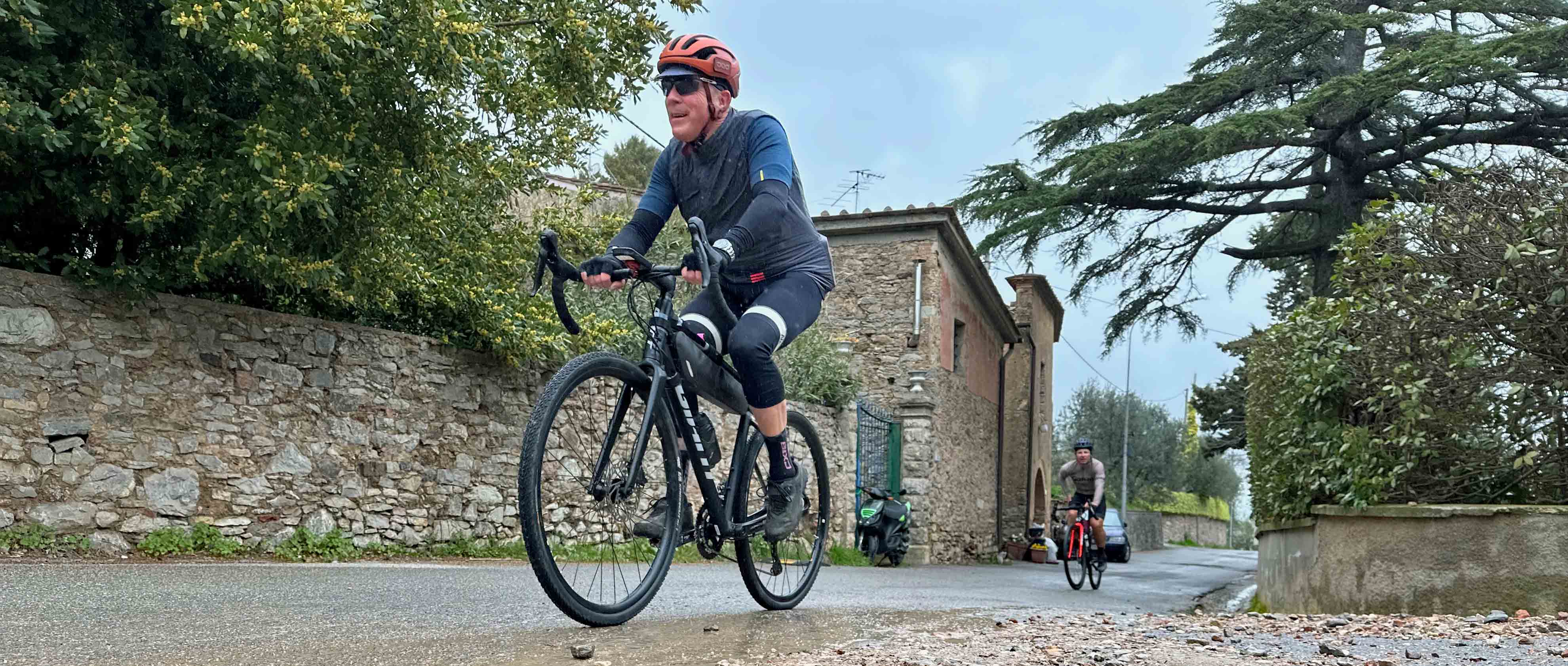
Stage 1 started as we meant to go on with a climb straight from the off. Initially on tarmac and with an ideal warm-up gradient, the opening section took us away from the thermal spa town of Casciana Terme and up into the surrounding Pisan hills, our first target a high col located at 552m above sea level. If I had looked more closely at the route map before we set off, I would have realised that there was an impressive clue to what potentially lay in store for us – the closest peak to our main col was called Poggio della Nebbia, which translates to the “hillock of fog”.
The forecasts all promised cool, grey and importantly dry conditions, but as we climbed higher, low cloud enveloped us. The initial dampness turned to drizzle and then to full-on rain. Glasses fogged. Wind jackets were soon soaked through. Droplets of water streamed off helmets and core body temperatures dropped. Despite the somewhat unwelcome conditions, something about the challenge over adversity helped to bond the group. From our high point, a super-fast and gravelly descent took us down, closer to civilisation and an opportunity to meet up with Daniele and our support vehicle for a change of clothes and the chance to top up our calories.
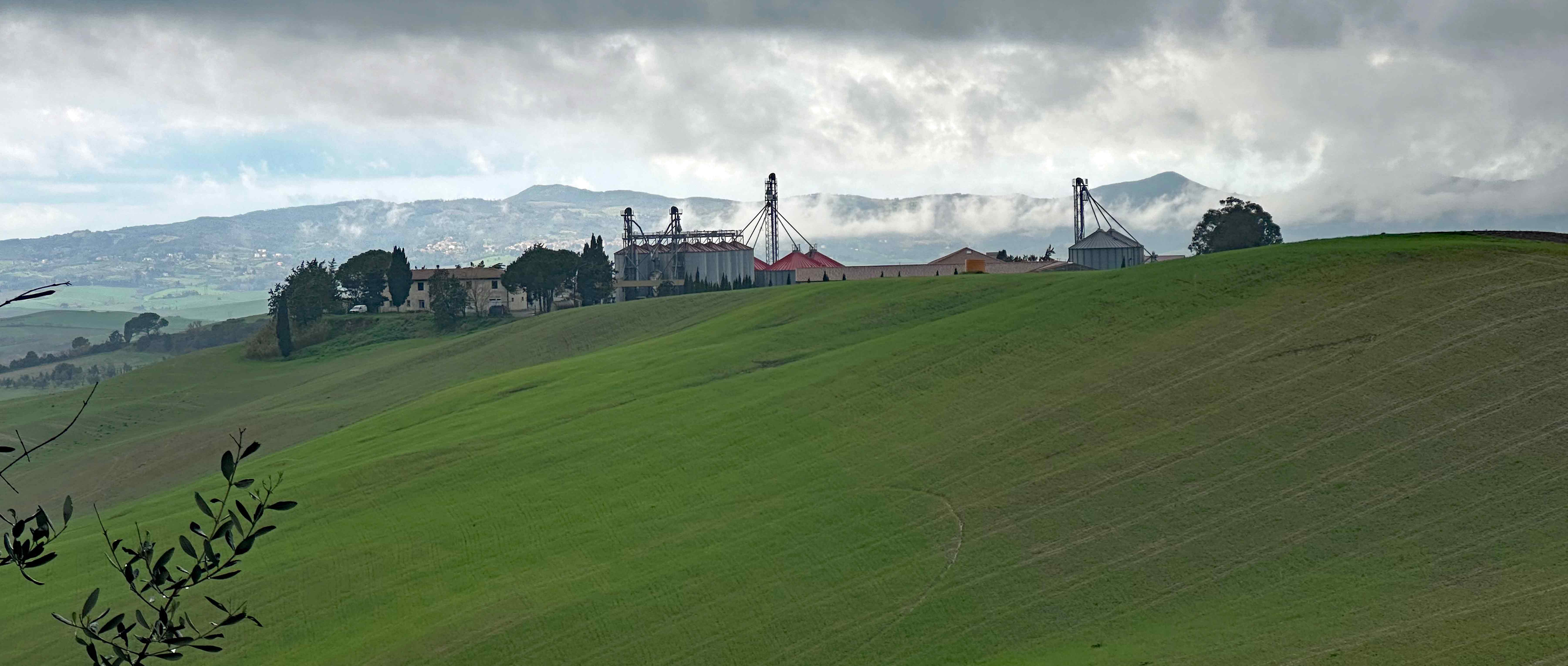
From our meet-up point, we were offered tantalising glimpses of what was to come. Velvety, grass-wrapped rolling hills, with summits wreathed in wispy clouds were visible across the valley from where we regrouped. Unfortunately, despite being lower, there was no let-up in the rain which started bouncing off the road. Luckily, the volume of traffic (as with the majority of the trip) was incredibly low and as we sluiced our way towards our next off-road section, we had the road mainly to ourselves.
After a quick re-grouping and route check, we picked up our next section of trail. Away from the heavily wooded hillsides that we initially traversed, we were now into a more typical Tuscan landscape of rolling hills, avenues of Cyprus trees, sporadically dotted villas and numerous small farms. The riding however was anything but typically Tuscan. This was not the smooth rolling ‘strada bianche’ so beloved of away-from-the-road cyclists. Our trail was vehicle width but that’s where the similarity ended. This was gravelplus, with long sections of rocks, stones & pebbles, water-cut erosion grooves (which necessitated regular line choice changes) and patches of heavy, clay-rich mud. The riding was as involving as the surrounding landscape was engaging. Full concentration was required and you could soon tell which of the group had more extensive off-road experience, compared to those who didn’t. For those who regularly got their tyres dirty, there were big, face-aching grins visible. OK, so the rain was still falling and we were liberally pebble-dashed with clay-based detritus, but the overarching feeling was that this was exactly what we had hoped for – a real challenge, stunning scenery and great company.
Sadly/fortunately (depending on how much you enjoyed technical gravel trails) the gravelplus trail soon gave way to smooth, graded gravel roads. We climbed gently along a broad ridge until we reached Daniele and his support vehicle. As we got to him, the skies noticeably brightened and by the time we had regrouped the sun was pushing through and spirits soared.
We took a group decision that the collective rumbling of stomachs took precedence over another hour of riding and so we made a beeline straight for our lunchtime stop – a small hilltop farm where the effervescent owner plied us with vast amounts of locally grown produce, including focaccia drenched in his own olive oil, delicious wine from a local producer and steaming plates of pasta rich with olive oil slicked tomato sauce. Everything we were given was focussed on seasonal, local ingredients, prepared simply and eaten in great surroundings.
Despite having spent less than 18 hours together as a group at this point, the unifying gravel-loving factor helped us break down social barriers and develop a brilliant group dynamic. Just in the period of one lunchtime, Michael was soon learning how to swear fluently (and loudly) in colloquial Italian, Erwin was given lessons in correct pasta management and Andrea was practically betrothed to the farm owner. Everyone else was busy filling their faces with delicious food, wine and coffee.
Post-lunch, despite the lure of a siesta, a quick glance at bike computers showed that we had completed less than a third of distance planned for the day, so we set off again, initially on paved roads before hitting a long section of gravel heaven. Tree-lined in some places, wide-open with great views across the rolling countryside in others and all lit up with some spring sunshine, this section was a very good antidote to the wet start to the day and raised everyone’s spirits dramatically.
The route profile for the afternoon showed quite a sting in the tail. First off, we had to tackle a 7 km gravel climb. The gradient and the surface were perfect for maintaining a steady speed and we got tantalising glimpses of the surrounding scenery through gaps in the heavily wooded hillside. As the gradient levelled off at the top of the climb, the character of the track changed dramatically. Gone was the perfectly compacted surface of our climb and in its place came its rockier, more aggressive older brother! The riders at the front of our mini-peloton were soon pushing the pace, but it needed every gram of concentration and energy that we could find to maintain a smooth course, steady speed and avoid the dreaded snakebite puncture. After a brief undulating section, the gradient turned in our favour, but the surface remained rocky/stony and everyone was unusually pleased when the off-road descent finished and we once again met a minor paved road.

We descended as a pack. The whir of our tyres on the tarmac and the buzz of our freewheels reverberated loudly as we flew through the tightly packed buildings in one of the hillside villages that we passed through, heading for our next destination – the Torrente Sterza river crossing.
“I’ll go and test it out and see if it’s rideable” said Daniele-the-guide, heading courageously into the water at quite a high speed. With the rest of the group sitting on the gravelly foreshore, phones and cameras in hand like vultures waiting for the kill, no-one was quite sure how he would get on. From the sidelines, the water didn’t look too deep, although a local fisherman standing close to our chosen fording point did seem to shake his head dubiously as he realised what we were planning to do. Initially, he made good speed and his chosen route looked to be a sage one, but then with a seemingly slow-motion splash, his front wheel dropped into an unseen hole in the riverbed and he was pitched unceremoniously over the bars and straight into the watery embrace of the river. Despite being completely soaked from head to toe, he was incredibly calm and seemingly unflustered, casually grabbing his bike as it started to float off downstream. After we finished laughing (sorry Daniele) and replaying the variety of images and video that we had shot, we resigned ourselves to a cold-water paddle and removed shoes and socks before wading gingerly across. Fortunately, the water wasn’t quite as cold as I had been anticipating – perhaps a side effect of all the nearby volcanic activity.
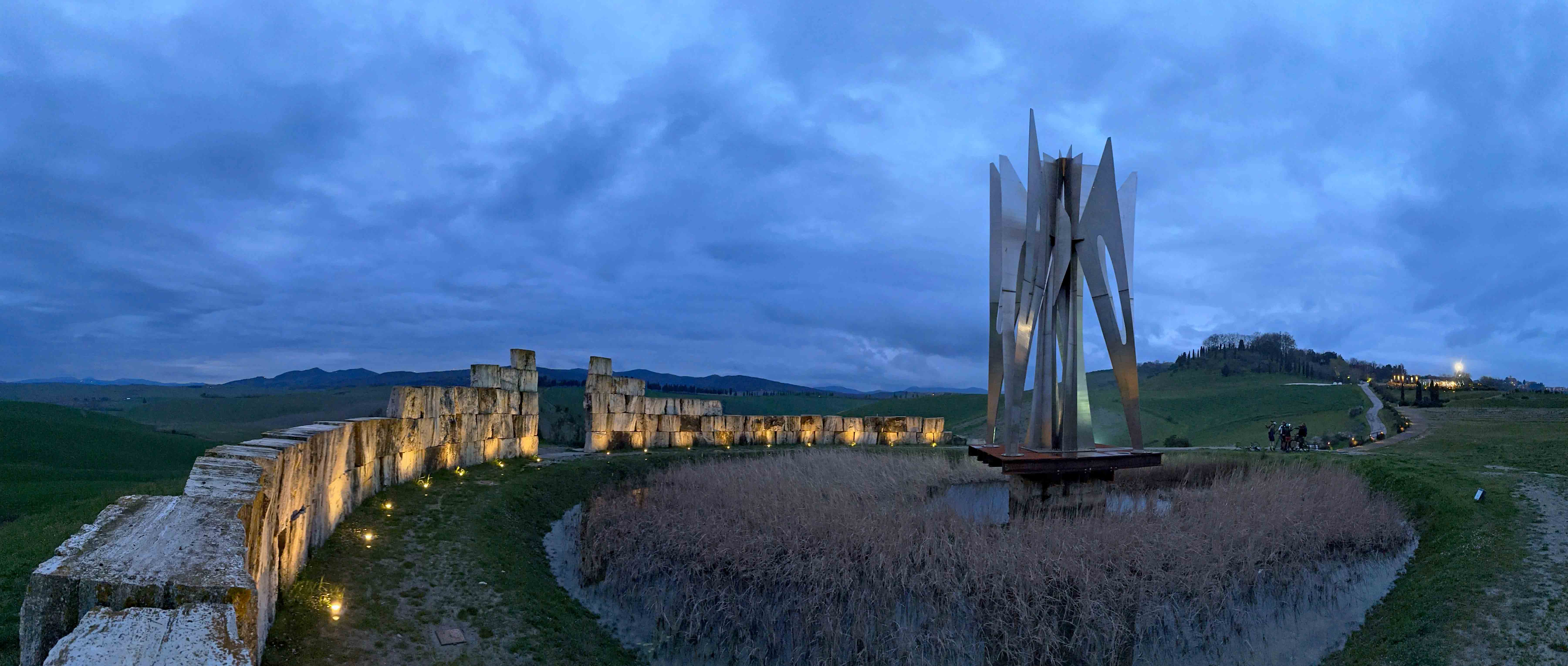
Fortunately, from the river crossing, we soon warmed up on the climb up to the nearby village of Lajatico, home to the amazing Theatre of Silence, a dramatic outdoor concert venue which holds an annual concert featuring some of Italy’s most famous musicians. This was the grand finale of Stage 1, only enhanced by Daniele-the-guide producing bottles of chilled beer – the perfect way to finish a great day.
Stage 2
Elsewhere in Europe, the arrival of the weekend would bring out people. Freed from the shackles of their day jobs, roads would see more traffic, shops would be bustling and everything would feel a little more “alive”. As soon as we left our overnight accommodation this did initially seem to be the case in central Tuscany too.
The road we were on crossed a former railway line now converted into a mixed-used recreational trail. As we descended towards it, our cyclist radar kicked in and we all spotted a large group of middle-aged men riding heavy-duty e-MTBs. Compared to the day before, when we had the roads and the trails to ourselves, this was quite a change, but it was still a tiny number relative to the number of cyclists you would expect to see further south in the more famous parts of Tuscany.
“There are just ten families left here” said the elderly lady, who had poked her head out an upstairs window in the ancient stone-built house that overlooked the tiny central square. We initially expected to be told off for creating such a racket outside her house, but instead, she was visibly delighted that a group of cyclists had made the effort to come and visit. When Daniele-the-guide explained to her that we were a group of journalists exploring the area and hoping to help attract more cycling visitors to the area, she was even more impressed. Her village was perched on a high promontory with beautiful views in all directions and had been reached by a fantastic hairpinned tarmac climb from the valley bottom.
Image courtesy of Erwin Sikkens
From the village, our route headed off-road and we traversed a long volcanic ridge, the vehicle-width trail gently rising and falling with the contours. Part way up one climb, off to the side came the audible sound of local pecorino sheep, most of whom wear bells around their necks which makes locating them simpler. Initially, we could hear, but not see them, but as we continued along the trail, we spotted a large flock sheltering in a small, wooded copse off to one side.
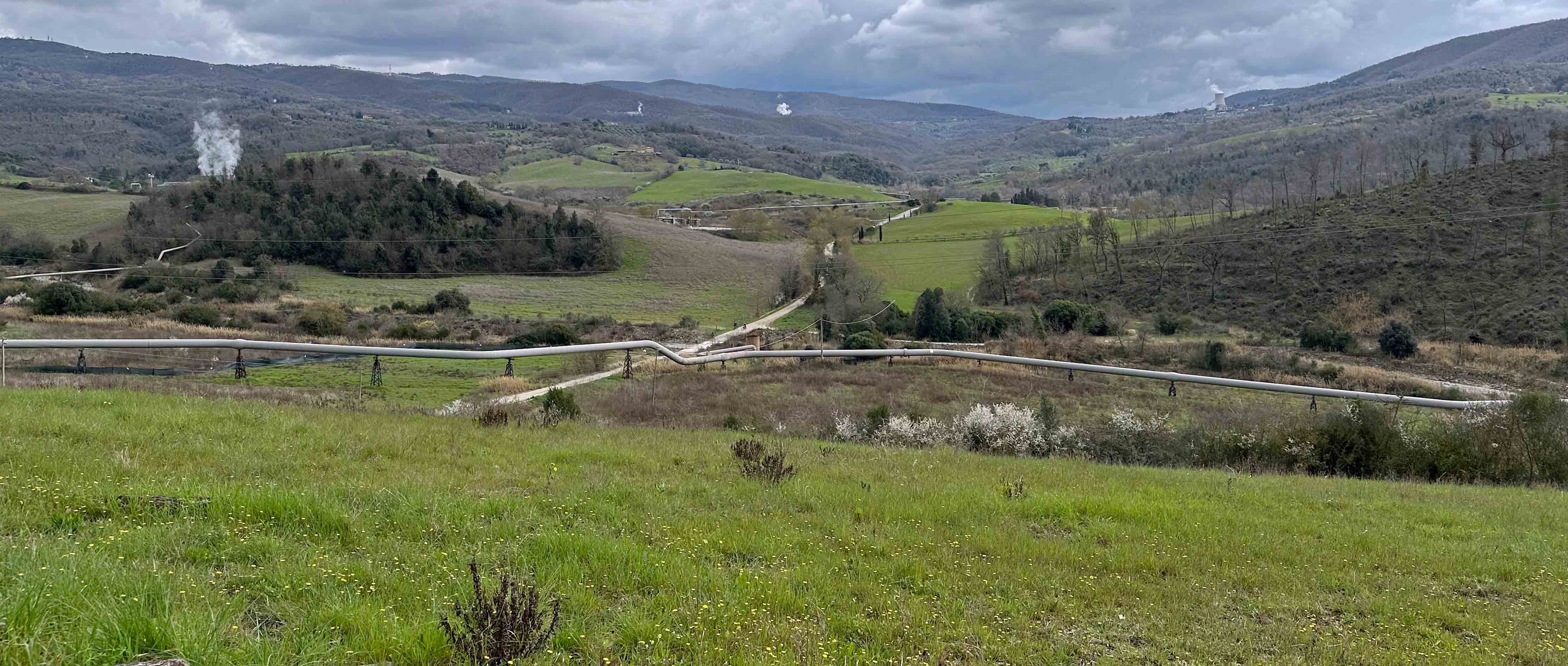
It was around this point that we noticed a distinctive smell. Initially, we put it down to the proximity of the sheep, but the smell was more sulfurous than you would typically associate with the warm-damp-wool smell of a flock of sheep. Shortly after, as our trail pointed steeply downhill, we passed under a large diameter stainless steel pipe. “That’s carrying steam from the volcanic vents to the power station where it generates electricity” said Daniele-the-guide. As we came around a corner, the view opened up to our left and like something out of a sci-fi film, the valley was crisscrossed with a network of these pipes. The entire region is volcanic and vast amounts of power and heat are extracted from the super-heated magma which lies close to the earth’s surface in this area.
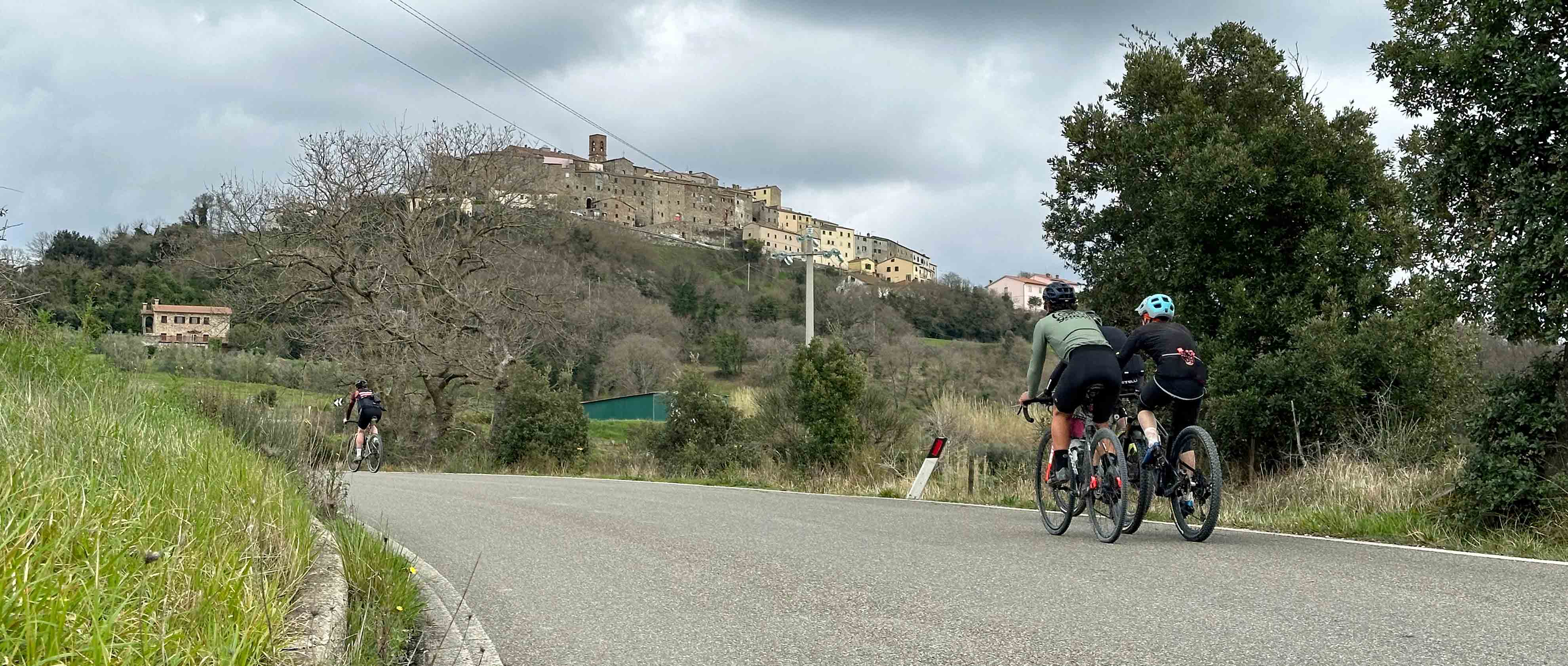
After a short stop at a concrete water splash (luckily safely crossed without any accidental swimming this time), our route started to climb. Today would have been described as the queen stage if we had been doing a Grand Tour, with my bike computer recording just shy of 1700m of total climbing for the stage. Just the climb to get up to our lunch spot was 10 km in length and that was only half of the distance to be ridden either side of lunch.

Lunch had been booked for us at a local attraction - a volcano-powered brewery and restaurant. As we climbed ever closer, vast plumes of steam were visible in places and the rotten egg smell became pretty pungent. As it was a Saturday the restaurant was busy, but the staff didn’t seem at all phased by a group of sweaty, ravenous gravel riders arriving on their threshold demanding sustenance! As part of our lunch, we got to sample some of the ten different beers that they brewed on-site. The brewery part of the business was able to be carbon-neutral due to its use of naturally occurring volcanic steam to power the different brewing processes.
Another delicious multi-course lunch was demolished. Erwin received Part Two of his “beginners guide to eating spaghetti like a local”, which caused great amusement (or should that be bemusement?) among the Italians at our table.
After lunch, we started part two of the climbing, initially on tarmac, with a brief stop to explore an area close to the road where some thermal vents were accessible on foot, we soon turned off and started to climb on gravel.
As we turned off the road, a sign indicated that we were joining a way-marked off-road cycling route. Unlike previous areas we had ridden through, this region appeared to be actively targeting mountain bikers to come and visit and there was a mix of waymarked vehicle width and singletrack trails marked on a large trailside map. The initial gradient was perfect, albeit not ideal with stomachs full of food, but as we climbed higher, the gradient kicked up and the surface degraded. Long sections of loose pebbles, sand and gravel were interspersed with larger fragments of rock. Traction was at a premium in places and the impact of large volumes of water descending off the hillside above was visible on the trail.
It was at this point a group of e-MTBers started to catch us. The lead riders were flying, but it was a very mixed-ability group and the riders at the back were actually slower than the lead riders in our ‘acoustic’ group. They were cheery and friendly but were obviously bemused by the fact we were attempting the same climb as them on gravel bikes fitted with 40mm tyres, compared to their choice of burly e-bike. The final section of the climb was brutal – steep, loose and sustained. I suspect most of our group secretly wished for some motorised assistance! It was rideable, but it was on the absolute limit of what was possible on a gravel bike. Fortunately, the view from the top and the sense of achievement made the effort worthwhile.
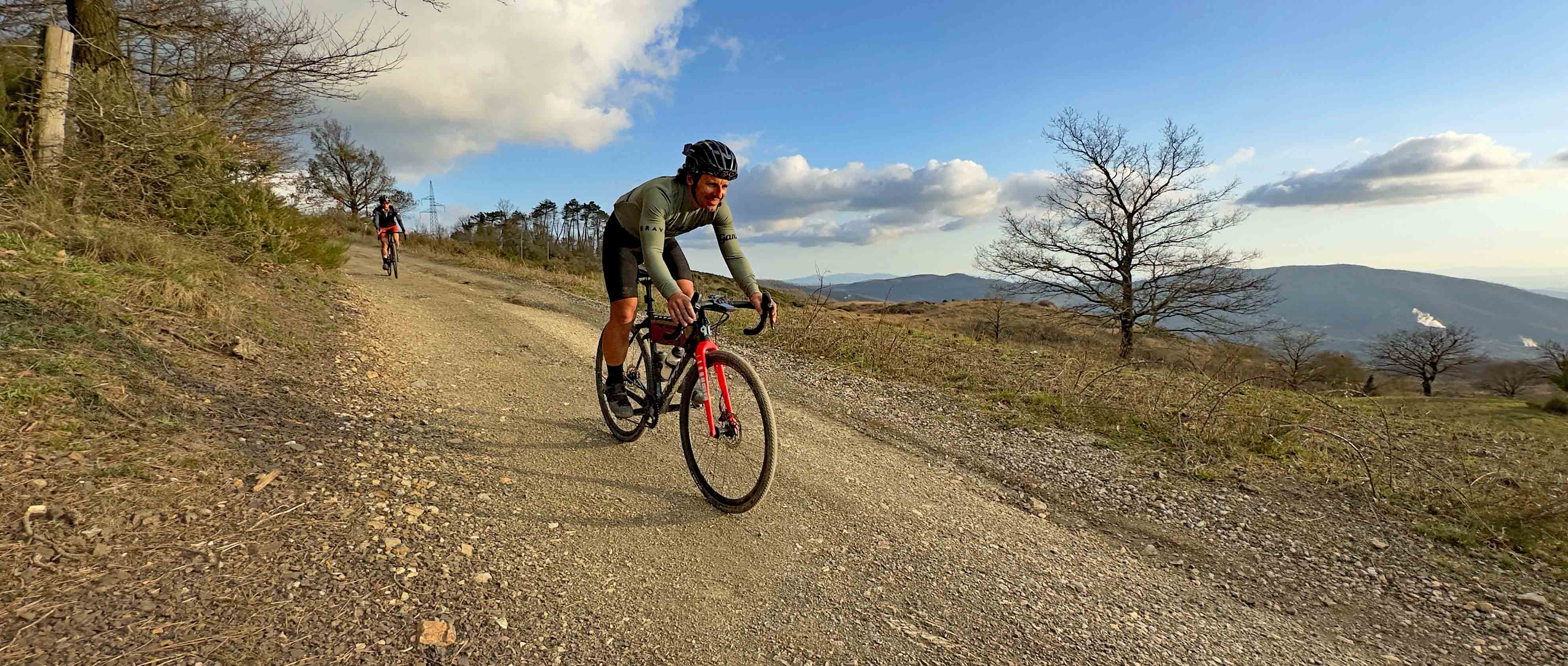
As we reached the first of the late afternoon’s false summits, the sun broke through the previous greyness and suddenly everything was bathed in golden light. Despite some subsequent sections of claggy mud, a few punctures and a minor tiredness-related accident, the group were soon all back together. The toll of the extended climbing was visible on the faces of some of the riders though and when we looked at the lateness of the day and the rapidly dropping sun, we realised we were likely to finish riding in the dark.
Whether by genius planning or sheer luck, the two Danieles had saved some dramatic scenery and the best light of the day for the final hour. As if to underline the eco-credentials of the area, our route wove a sinuous path past a giant array of solar panels and then through the grounds of a vast geothermal power station. Not beautiful in the traditional sense, but inspiring that so much energy could be harnessed in such a responsible and renewable manner.
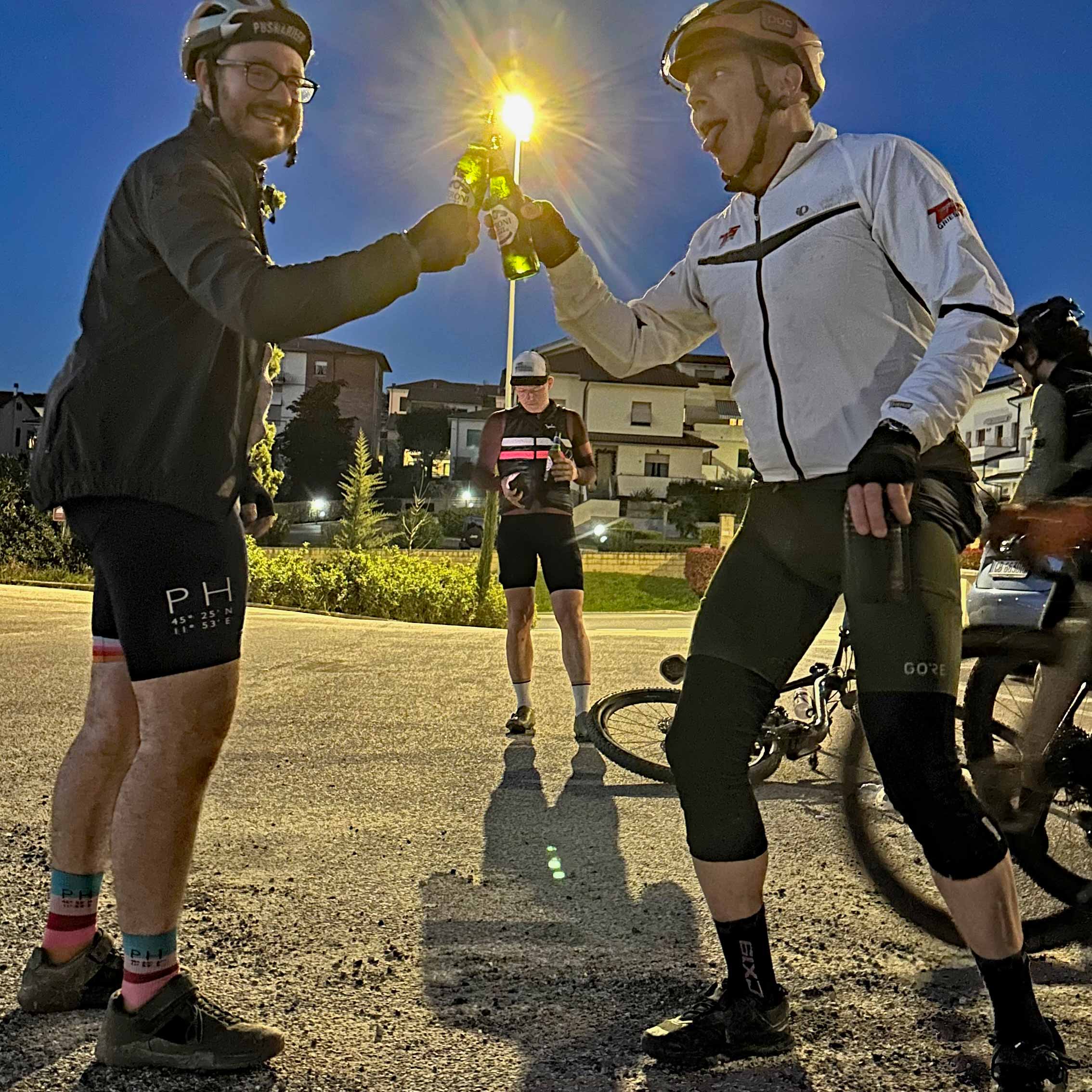
There’s something magical about finishing a long ride in the dark, particularly when you haven’t really planned it in. The finale of the day’s ride was on a super-fast flowy tarmac road. With the low level of light came an increased awareness of our surroundings – we relied less on vision and more on ‘feel’ and this helped create a huge buzz. Despite the tired legs and dropping temperatures, we were a happy group when we made it to the end of the stage. This was only topped off thanks to Daniele-the-guide coming up trumps with another bag of cold beers to celebrate our arrival at the finish point.

A short transfer later, we were dropped off in the magical city of Volterra. Perched on top of an impressively steep-sided hill, the medieval heart of the city is beguiling, with narrow cobbled streets, ancient buildings and a calm, relaxed, atmosphere.
Stage 3
The forecast for the final day of riding predicted early morning mist, but with sunshine soon burning through. This meant just one thing – a potential cloud inversion, something that all budding photographers will gladly sacrifice some sleep to witness and try to capture.
Fellow photographer Erwin and I were up early and first headed out on foot to explore the diminutive but beautiful city, before shovelling in a speedy breakfast, packing our bags and heading out for some additional two-wheeled exploration before we met up with the rest of our group. We swapped roles as photographer and muse, trying to capture the golden early morning light bouncing off the honeyed stone buildings.
Our third and final stage of riding was set to be the closest we got to experience riding on the typical Tuscan strada bianche - white roads, so named because they are generally constructed from pale-coloured crushed limestone aggregate.
The ride started with a brief exploration of the cobbled streets of Volterra, before we took on a screamingly fast and swoopy paved road descent through flower-filled olive groves. After a brief interlude, we regained all the height we had just lost, but this time we climbed on strada bianche. Like something out of a tourist brochure, the climb lazily zigzagged up through manicured farmland, along Cyprus tree lined avenues and past ancient hilltop villas.
The stage was front-loaded in terms of distance and climbing and at points, the fatigue of the last couple of days began to make themselves felt. The whole stage was only 60 km in length, but the climbing felt significantly greater than the 1200m my bike computer registered.
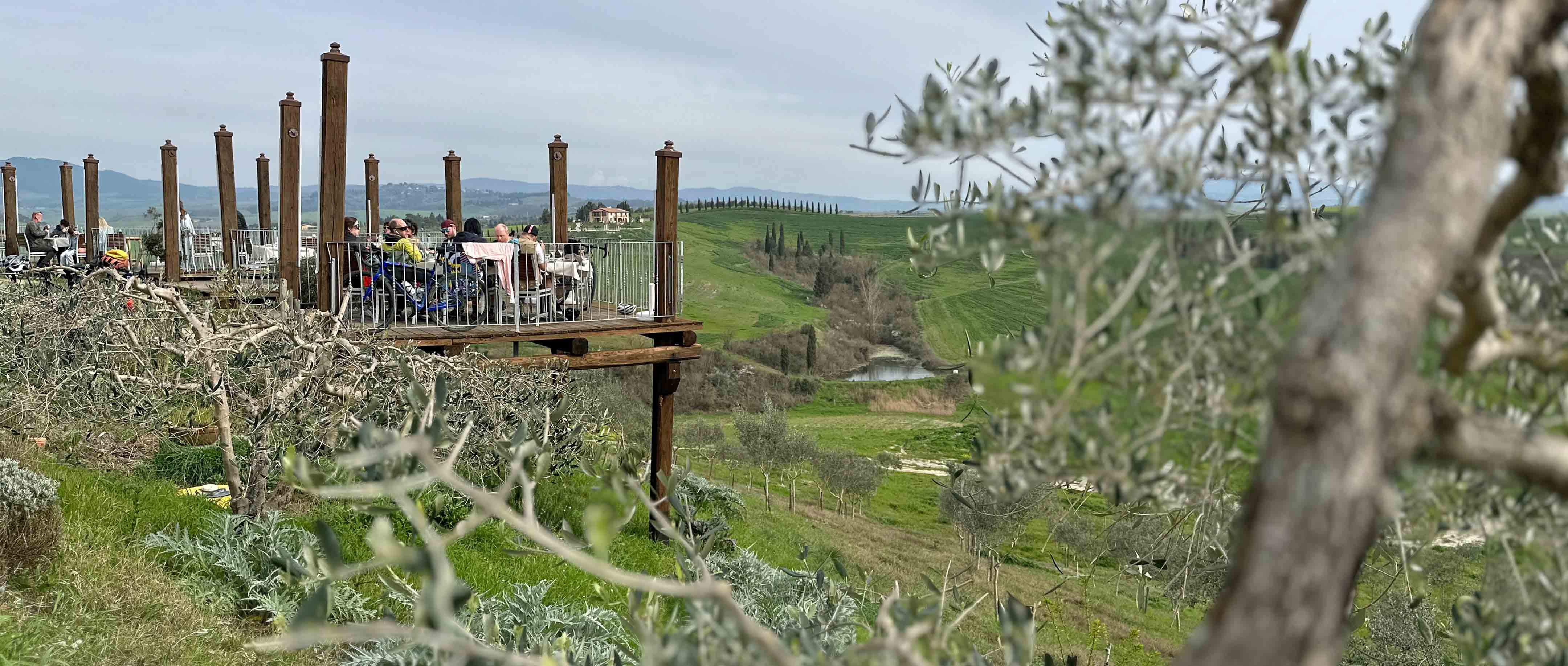

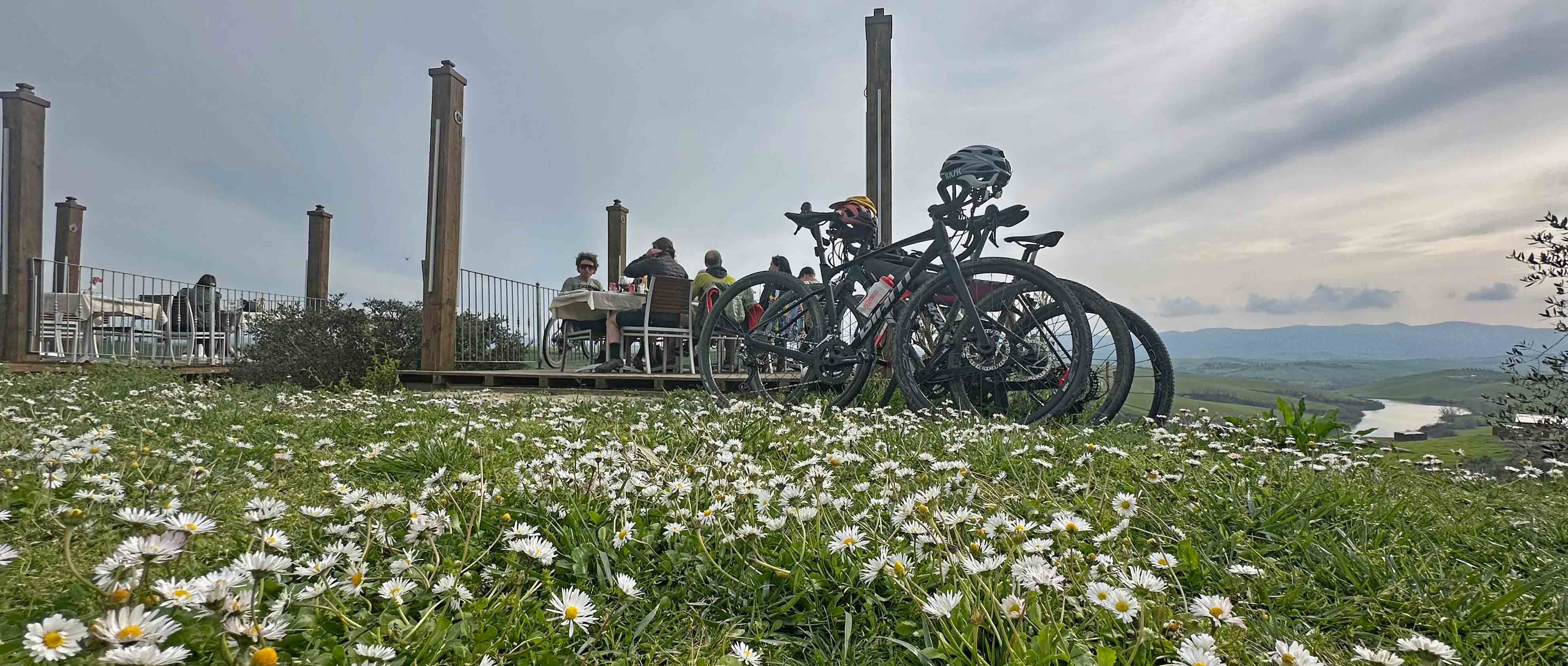
Image courtesy of Erwin Sikkens
With some precision planning, the two Danieles had arranged for our final lunch spot to be the real highlight of the trip, both in a culinary and a gastronomic sense. They had booked us into a stunningly located outdoor restaurant, situated on the edge of a chalk escarpment. With some clever engineering, each of the groups dining there were allocated a private deck which appeared to be cantilevered out over the olive trees and artichoke plants, from which the restaurant sourced some of their raw ingredients. Daniele-the-guide pointed out on the far horizon where the Teatro di Silenzio was located (where we had finished the end of the first stage). We all nodded as he described exactly where to find it, but I suspect the combination of delicious local wine and a certain amount of press-trip-brain-fog meant we weren’t 100% sure where to look!
With another mammoth amount of delicious calories taken on board, it was an initially sluggish start to the afternoon’s ride, but this hiatus was only temporary. Within a very short distance of the restaurant, it became apparent that we would need to switch on our riding brains again. The wet weather from Stage 1 had obviously been spread across the entire region, as the chalky trails that we were going to be riding had turned to a clay-rich sludge. With a combination of luck, skill and blind faith, each rider selected their chosen line and attempted to get through it as well as they could. There were several patches of deep, clayey, ooze with often only a tiny dry line at the extreme margin of the track. Fortunately, everyone bar Michael made it through unscathed – he tried valiantly to balance riding one-handed with taking photos, but the gods of “fango” (mud, in Italian) were obviously not on his side and at one point he was unceremoniously booted off the side of the trail into the field below.
The afternoon and the entire trip finished on a high. Swoopy strada bianche through stunning rolling countryside, a high-speed (and ultimately futile) chase along an undulating paved road, a short stretch of segregated bike path shared with Sunday afternoon families out for a two-wheeled passeggiata and a grand finale – watching the sunset from a stunning viewing platform in the hilltop town of Peccioli.
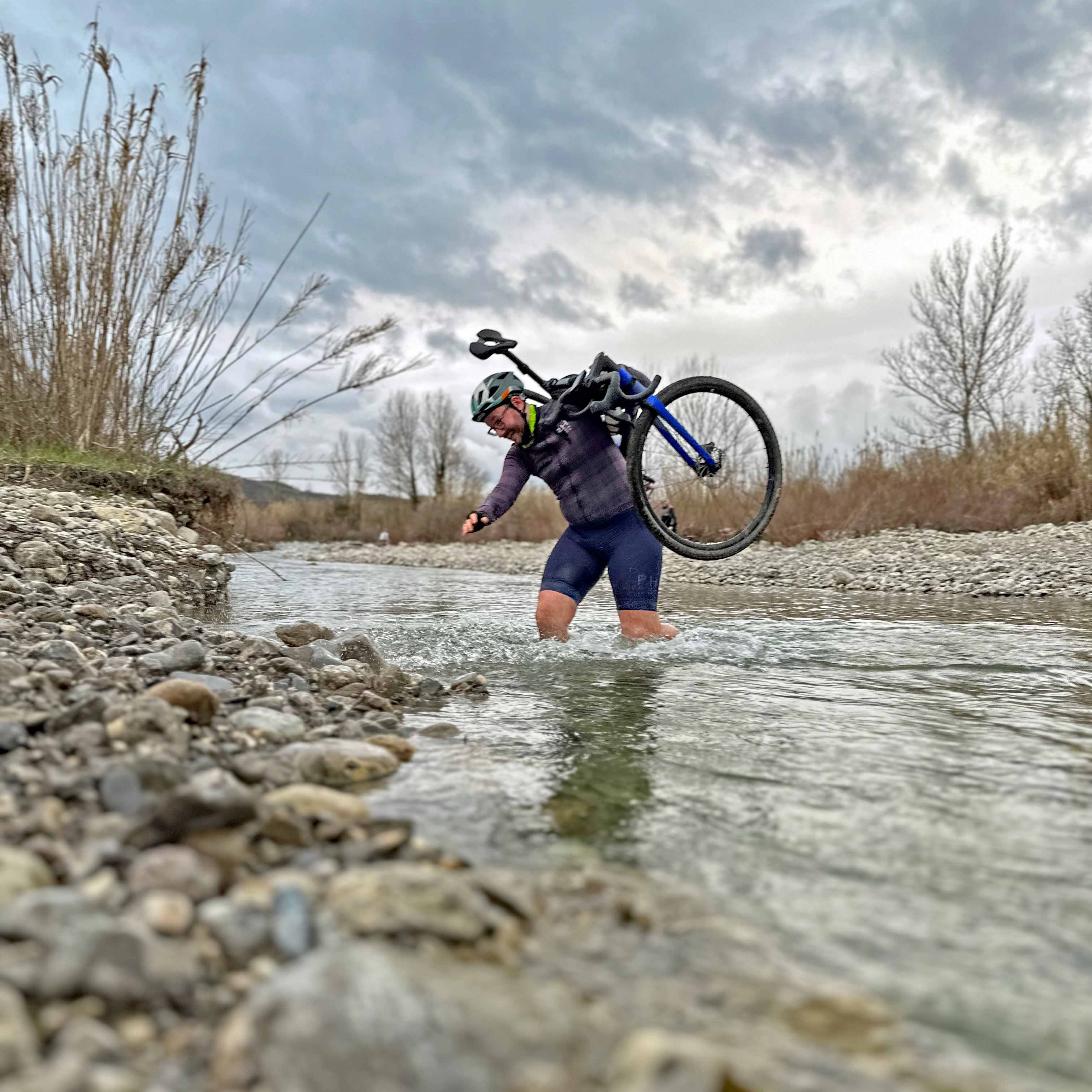
I was trying to find one image from the huge number that I shot during the press trip which captured the essence of the Terre di Pisa Bike Trail and I think this is probably it. Pietro, wading through knee-deep volcanically warmed water with a facial expression which is a mix of determination, concentration and amusement, sums up the trail pretty eloquently. It’s by no means an easy route and the combination of length, amount of climbing and the varied surfaces you will encounter means it feels more suited to experienced riders than beginners, but for anyone willing to put in the effort, the rewards will be huge.
The route was created to take gravel riding visitors away from the typical Tuscan honeypot sites and to experience a quieter, more distinctive version of this incredible place. Sure, at points along the way you will experience some of the more famous parts of the region, but even then, arriving by bike will give you a completely different (and in my mind, significantly better) experience than the visitors who arrive by car or by tour bus.
Although it might sound like cheesy marketing blurb, the Terre di Pisa Bike Trail really will show you a more authentic version of Tuscany. Our three-day press trip barely scratched the surface of what the full route will offer and I can’t wait to go back and try out the real thing.
If you’d like to find out more about the route, you should check out their newly launched website.
If you fancy taking part in the inaugural bikepacking event which will take in the whole of the route and which will be starting in Pisa on Wednesday 9th October, you should add your name to the mailing list here and full details will be sent out to you as soon as they’re ready.